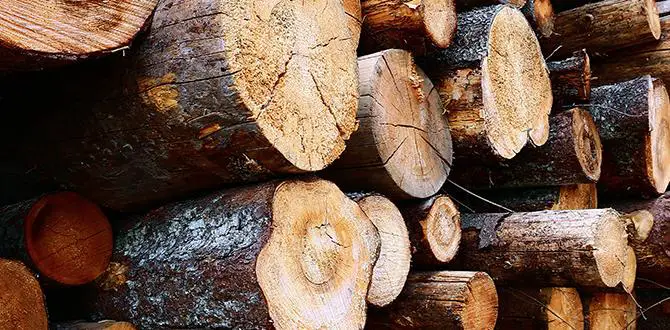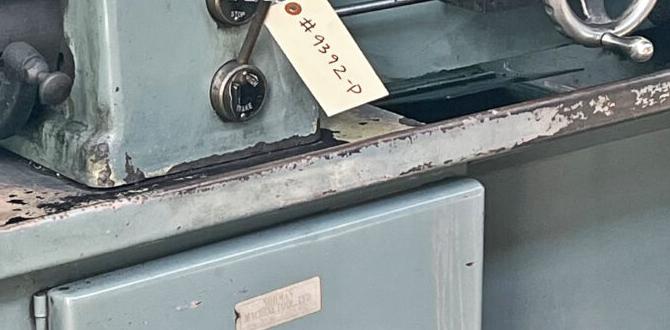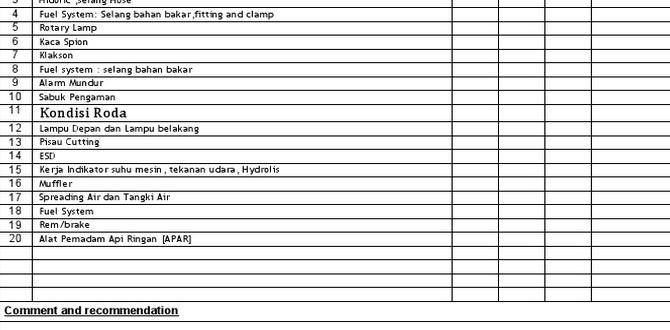Choose the right cutter for your lathe to achieve precise, clean cuts, extend tool life, and ensure safe, successful machining. Understanding cutter types, materials, and edge geometry is key to unlocking your lathe’s full potential, whether you’re working with wood or metal.
So, you’ve got a lathe humming, ready to shape something amazing. But when it comes to choosing the right “cutter for lathe,” it can feel a bit like staring at a wall of shiny metal without a map. It’s easy to get overwhelmed by the sheer variety, and picking the wrong one can lead to frustrating chatter, rough finishes, or worse, a broken tool and a damaged workpiece. Don’t worry! As a seasoned machinist, I’ve been there, and I’m here to demystify this essential part of lathe work. We’ll break down exactly what makes a cutter perform its best, from its material to its shape, so you can confidently select the perfect tool for your project and get those clean, professional results you’re aiming for.
What is a Lathe Cutter and Why Does it Matter?
A lathe cutter, often called an insert or a tool bit, is the business end of your lathe. It’s the sharp part that actually removes material from your workpiece as it spins. Think of it as the artist’s chisel or the chef’s knife – its quality and suitability directly determine the outcome of your work. A good cutter makes machining feel smooth, accurate, and satisfying. A poor choice, however, can result in rough surfaces, inaccurate dimensions, excessive tool wear, and even dangerous situations.
The performance of a cutter for your lathe is measured by several key factors:
Sharpness: How well it holds an edge.
Durability: How long it lasts under pressure.
Material Removal Rate: How efficiently it can cut.
Surface Finish: The quality of the finish left on the workpiece.
Chip Control: How it breaks and manages the material being removed.
Understanding these elements helps you select the right cutter for specific tasks and materials, ensuring your lathe operates at its peak efficiency and safety.
Types Of Lathe Cutters: Finding Your Perfect Match
Lathe cutters come in a dazzling array of shapes and sizes, each designed for a specific purpose. For beginners, it’s helpful to categorize them by their primary function.
Turning Cutters
These are the most common cutters and are used for reducing the diameter of a workpiece. They come with different geometries to handle roughing (removing a lot of material quickly) and finishing (creating a smooth surface).
Roughing Cutters: These have a strong, often rounded nose, designed to tackle heavy cuts and rapidly reduce material. They generate larger chips.
Finishing Cutters: These have finer details, such as a sharp point or a very small radius nose, to leave a smooth surface with minimal material removal. They produce smaller, more manageable chips.
Facing Cutters
Used to create a flat surface on the end of a workpiece. They typically have a carbide insert held in a steel body that moves across the face of the rotating material.
Grooving Cutters (Parting Tools)
These are narrow cutters used to cut grooves or to cut a workpiece completely off the lathe. They require very stable setups due to the high pressure applied.
Threading Cutters
Specialized inserts designed to cut screw threads onto a workpiece. They come in various profiles for different thread types (e.g., V-threads, square threads).
Boring Bars
These are essentially internal turning tools. They are bars with a cutter insert mounted at the end, designed to enlarge or shape the inside diameter of a hole.
Cutter Materials: The Heart of Performance
The material a cutter is made from is crucial for its performance, especially when dealing with different workpiece materials like mild steel, aluminum, brass, or wood. The hardness, heat resistance, and toughness of the cutter material dictate how it behaves under the extreme conditions of cutting.
High-Speed Steel (HSS)
HSS is a classic choice for many machinists, especially for woodworking lathes and some metalworking applications.
Pros: It’s relatively inexpensive, easy to grind and resharpen to a keen edge, and it’s quite tough (less prone to chipping than carbide). It performs well at lower speeds and temperatures.
Cons: It loses its hardness at higher temperatures, meaning it can’t be used for very fast cuts or sustained high-speed machining without significant wear or softening.
For beginners, HSS is a great starting point because it’s forgiving and easy to learn with. You can find HSS tool bits in many standard shapes.
Carbide Inserts
Carbide is a modern workhorse in metal machining. It’s typically a metal alloy, often tungsten carbide, brazed or pressed onto a substrate. These are usually available as replaceable inserts that fit into a tool holder system.
Pros: Extremely hard and can withstand much higher cutting temperatures, allowing for faster cutting speeds and better tool life. They maintain their sharpness for longer periods.
Cons: More brittle than HSS, meaning they can chip or shatter if subjected to shock or improper use. They also require specific grinding wheels if resharpening is needed (though often they are simply replaced). They are also more expensive upfront.
Carbide inserts are graded for different applications, which we’ll touch on later.
Cermets
A hybrid material combining ceramic and metal elements.
Pros: Offer excellent hardness and wear resistance, often outperforming standard carbide in finishing applications and at higher speeds. They can provide a superior surface finish.
Cons: Can be more brittle than carbide and sensitive to thermal shock.
Ceramics
These are very hard, brittle materials (like aluminum oxide or silicon nitride).
Pros: Extremely hard, allowing for very high cutting speeds and excellent surface finishes, especially on hard materials.
Cons: Very brittle and prone to chipping. They are not tolerant of interrupted cuts or heavy shock.
Polycrystalline Diamond (PCD)
The hardest cutting material available.
Pros: Superior hardness and wear resistance, ideal for non-ferrous metals and composite materials like plastics and carbon fiber. Unmatched tool life.
Cons: Extremely expensive and brittle. Only suitable for specific applications and materials.
Understanding Tool Geometry: The Shape of Success
The shape of the cutting edge, known as the geometry, is as vital as the material. Different angles and forms influence how the cutter interacts with the workpiece, affecting chip formation, cutting force, and surface finish.
Rake Angles
Positive Rake: The cutting face slopes away from the workpiece. This results in a sharper cutting edge, lower cutting forces, and better chip flow. It’s good for softer materials and finishing cuts.
Negative Rake: The cutting face slopes towards the workpiece. This creates a stronger cutting edge but requires more force and generates more heat. It’s suitable for harder materials and heavy roughing passes.
Zero Rake: The cutting face is perpendicular to the workpiece. A compromise between positive and negative rake.
Clearance Angles (Relief Angles)
These are the angles behind the cutting edge that prevent the tool from rubbing against the workpiece.
End Clearance: The angle on the side and end of the tool that clears the rotating workpiece.
Side Clearance: The angle on the side of the tool that clears the previously cut surface.
Incorrect clearance angles lead to rubbing, increased heat, poor finish, and premature tool wear.
Nose Radius
The shape of the very tip of the cutting tool.
Small Nose Radius: Produces a finer surface finish but can be more prone to vibration and chatter (a resonant vibration that creates a rough surface).
Large Nose Radius: Can handle heavier cuts and is more stable, but may leave a coarser finish.
For beginners, a moderate nose radius on turning tools (e.g., 0.030″ to 0.060″ or 0.8mm to 1.6mm) often provides a good balance between finish and stability.
Choosing the Right Cutter: A Practical Guide for Beginners
When you’re starting out, focus on these key factors to make informed decisions and avoid common pitfalls.
1. Know Your Lathe
Machine Size and Power: A small hobby lathe won’t handle the same robust cutters or heavy cuts as a large industrial machine. Ensure your cutters are appropriately sized and rated for your lathe’s capabilities.
Tool Holder System: If you’re using modern metal lathes, they often use standardized tool holders for carbide inserts. Make sure your inserts fit your holders correctly. For woodworking, this is less of a concern as tools are often traditional HSS shapes.
2. Understand Your Workpiece Material
Different materials require different cutters.
Wood: Generally softer. HSS cutters are excellent. Specific woodworking gouges, skew chisels, and scrapers are used. They need to be kept very sharp.
Soft Metals (Aluminum, Brass): Can be machined with sharp HSS or specific carbide grades. Positive rake angles are often beneficial here for a smooth finish.
Medium Steels (Mild Steel, Carbon Steel): Often require HSS or more robust carbide grades. Neutral or slightly negative rake might be used for tougher cuts. Ensure good chip control.
Hard Materials or High-Speed Machining: These demand carbide or cermet inserts with specific grades and appropriate geometries.
A fantastic resource for understanding cutting tool materials and applications is provided by the Carbide Processors website, which details various carbide grades and their uses.
3. Select the Right Cutter Type for the Job
For turning (reducing diameter): Start with a general-purpose HSS or carbide insert turning tool. A left-hand and right-hand turning tool are essential.
For facing (flattening ends): Invest in a facing tool or a turning tool that can be mounted to face effectively.
For parting/grooving: A narrow parting tool for separating work or cutting grooves.
For internal work (boring): A boring bar set is necessary if you plan to create or enlarge holes from the inside.
4. Consider Carbide Insert Grades
If you’re using carbide inserts, you’ll see codes like P10, P20, M10, K20, etc. These denote the International Organization for Standardization (ISO) grades.
P-grades (Blue Band): For machining long-chipping materials (like mild steel). Used for general turning and finishing.
M-grades (Yellow Band): For stainless steel and some cast irons. Good all-around performance, offering a balance of toughness and wear resistance.
K-grades (Red Band): For non-ferrous metals (like aluminum, brass) and soft materials. Excellent for high speeds but less wear-resistant on steels.
H-grades (Green Band): For very hard materials (hardened steels, cast iron above 45 HRC).
A good starting point for general metal machining on a hobby lathe is often an M-grade or a versatile P-grade insert. Always check the manufacturer’s recommendations for specific applications.
5. Tool Holders and Shanks
For metalworking, cutters are typically held in tool holders. These holders grip the shank of the tool bit (if HSS) or accept interchangeable carbide inserts. Ensure the holder is the correct size for your lathe’s tool post and that your tool bits or inserts are securely clamped. A shank is simply the body of the tool bit.
Square Shanks: The most common for general-purpose turning and facing tools.
Round Shanks: Used for boring bars.
A basic set of HSS tool bits in square shanks (e.g., 1/4″ or 3/8″ depending on your lathe) is invaluable. For carbide, a simple round shank boring bar and a general-purpose turning tool holder are excellent additions.
Essential Lathe Cutters for Every Beginner’s Toolkit
Here’s a recommended starter set for both wood and metal lathes.
For Wood Lathes (Typically HSS)
Woodturning requires specialized tools that differ from metal cutting.
Spindle Gouge: For shaping spindles and smaller, cylindrical parts. It has a fluted shape.
Bowl Gouge: A larger gouge with a deeper flute, used for shaping bowls and more convex forms.
Skew Chisel: A versatile tool for fine finishing, scraping, and creating details.
Scrapers: Flat-bladed tools used for smoothing difficult grain or for final finishing.
Parting Tool: A narrow parting tool for separating pieces or creating rebates.
It’s generally recommended to buy good quality HSS woodturning tools, as they hold an edge much better and are easier to sharpen. Learning to sharpen your wood chisels is a fundamental skill. The Wood Magazine excellent guide on sharpening provides step-by-step instructions.
For Metal Lathes (HSS and Carbide)
A good starting point for metal lathes involves a mix of HSS and replaceable carbide inserts.
HSS Tool Bits (Square Shank):
High-Speed Steel 61-Degree Left-Hand Turning Tool: For general turning from right to left.
High-Speed Steel 61-Degree Right-Hand Turning Tool: For general turning from left to right.
High-Speed Steel Round Nose Scraper: For rounding over edges and finishing.
High-Speed Steel Cut-off Tool (Parting Tool): For cutting off workpieces.
High-Speed Steel Threading Tool: For cutting external threads.
High-Speed Steel Knurling Tool (Optional): For creating textured grips.
Carbide Insert Tooling:
General Purpose Turning Tool Holder: Accepts common triangular or diamond-shaped carbide inserts.
Assortment of Carbide Inserts: Include general turning (e.g., CNMG, TNMG), finishing (e.g., positive rake inserts), and perhaps some P or M grade inserts.
Boring Bar and Inserts: For internal work. Start with a common size, like 1/2 inch or 12mm shank, with a set of general-purpose inserts.
| HSS Tool Type | Primary Use | Best For | Notes |
| :———————- | :——————————————– | :—————————————- | :—————————————- |
| Turning Tool (LH/RH) | Reducing diameter, shaping external | General purpose, all materials | Need both left and right hand for versatility |
| Round Nose Scraper | Smoothing, rounding edges, finishing passes | Finishing, detail work | Easy to use, forgiving |
| Cut-off Tool | Cutting workpieces to length, parting grooves | Separating parts, creating narrow grooves | Requires rigidity, can be prone to bending |
| Threading Tool | Cutting screw threads | Internal and external threading | Specific insert for each thread pitch/type |
| Facing Tool | Creating flat surfaces on the end | Flattening ends of turned parts | Can be a modified turning tool or specific type |
| Carbide Insert Shank Size | Common Insert Shapes Supported | Typical Applications | Beginner Recommendation |
| :———————— | :—————————– | :——————————————————- | :———————- |
| 1/2″ (12mm) or 5/8″ (16mm) | Triangular, Diamond, Square | General Turning, Facing, Grooving, Boring | Start with a few versatile inserts and one holder |
| Round Shank Boring Bar | Varies (often triangular) | Internal diameter cutting, enlarging holes | Essential for internal work |
| Parting Tool Holder | Narrow Blades | Cutting off workpieces, deep grooves | Requires a robust holder |
The Importance of Sharpness and Maintenance
No matter how high-quality your cutter is, it’s only effective if it’s sharp and well-maintained.
For HSS: Regular grinding is essential. Learn to use a grinding jig or a bench grinder with the correct abrasive wheels (e.g., aluminum oxide) to maintain the correct cutting and clearance angles. A sharp HSS tool will glide through material; a dull one will rub and generate heat.
For Carbide Inserts: While they are very hard, they are also brittle. Avoid hitting them with other metal objects or dropping them. If an edge becomes chipped or dull, it’s usually best to discard the insert and replace it. The cost of replacement is often less than the time and frustration of trying to salvage a damaged insert. Keep inserts clean; swarf (metal chips) can embed and cause damage or poor finish. Check the OSG Tool Catalog for examples of insert geometries and their applications in machining.
Safety First: Using Lathe Cutters Properly
Lathe work, especially with metal, involves high speeds and sharp tools. Safety cannot be overstated when using any cutter for a lathe.
Secure the Workpiece: Ensure your workpiece is firmly mounted in the chuck or between centers. A loose workpiece is extremely dangerous.
Secure the Tool: Ensure your tool bit or insert is rigidly held in the tool post. Half-mounted tools can shift, leading to catastrophic tool failure or workpiece damage.
Proper Speed and Feed: Start with slower speeds and lighter feeds, especially when learning. Gradually increase as you gain confidence and understand how the cutter is performing. Too fast a speed generates excessive heat; too heavy a feed can break the tool.




